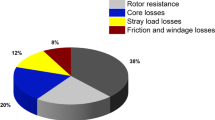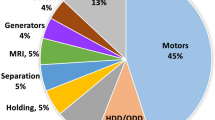Abstract
The correlation between the stress concentration and the spontaneous magnetic signals of metal magnetic memory (MMM) was investigated via tensile tests. Sheet specimens of the Q235 steel were machined into standard bars with rectangular holes to obtain various stress concentration factors. The tangential component Hp(x) of MMM signals and its related magnetic characteristic parameters throughout the loading process were presented and analyzed. It is found that the tangential component Hp(x) is sensitive to the abnormal magnetic changes caused by the local stress concentration in the defect area. The minimum magnetic field is positively correlated to the magnitude of the load and the distance from the notch. The tangential magnetic stress concentration factor presents good numerical stability during the entire loading process, and can be used to evaluate the stress concentration factor. The results obtained will be a complement to the MMM technique.
Similar content being viewed by others
References
Doubov AA. Screening of Weld Quality Using the Magnetic Metal Memory Effect[J]. Weld. World, 1998, 41(3): 196–199
Doubov AA. The Express Technique of Welded Joints Examination with Use of Metal Magnetic Memory[J]. NDT&E Int., 2000, 33(6): 351–362
Yang E, Li LM, Chen X. Magnetic Field Aberration Induced by Cycle Stress[J]. J. Magn. Magn. Mater., 2007, 312(1): 72–77
Huang SL, Li LM, Shi KR, et al. Magnetic Field Properties Caused by Stress Concentration[J]. J. Cent South. Univ., 2004, 11(1): 23–26
Wang HP, Dong LH, Dong SY, et al. Fatigue Damage Evaluation by Metal Magnetic Memory Testing[J]. J. Cent South. Univ., 2014, 21(1): 65–70
Roskosz M, Gawrilenko P. Analysis of Changes in Residual Magnetic Field in Loaded Notched Samples[J]. NDT&E Int., 2008, 41(7): 570–576
Shi CL, Dong SY, Xu BS, et al. Metal Magnetic Memory Effect Caused by Static Tension Load in a Case–hardened Steel[J]. J. Magn. Magn. Mater., 2010, 322(4): 413–416
Dong LH, Xu BS, Dong SY, et al. Stress Dependence of the Spontaneous Stray Field Signals of Ferromagnetic steel [J]. NDT&E Int., 2009, 42(4): 323–327
Yao K, Wang ZD, Deng B, et al. Experimental Research on Metal Magnetic Memory Method[J]. Exp. Mech., 2012, 52(3): 305–314
Leng JC, Xu MQ, Xu MX, et al. Magnetic Field Variation Induced by Cyclic Bending Stress[J]. NDT&E Int., 2009, 42(5): 410–414
Huang HH, Jiang SL, Liu RJ, et al. Investigation of Magnetic Memory Signals Induced by Dynamic Bending Load in Fatigue Crack Propagation Process of Structural Steel[J]. J. Nondestruct. Eval., 2014, 33(3): 407–412
Shi CL, Dong SY, Xu BS, et al. Stress Concentration Degree Affects Spontaneous Magnetic Signals of Ferromagnetic Steel under Dynamic Tension Load[J]. NDT&E Int., 2010, 43(1): 8–12
Huang HH, Jiang SL, Chen Y, et al. Stress Concentration Impact on the Magnetic Memory Signal of Ferromagnetic Structural Steel[J]. Nondestruct. Test. Eva., 2014, 29(4): 377–390
Dong LH, Xu BS, Dong SY, et al. Characterisation of Stress Concentration of Ferromagnetic Materials by Metal Magnetic Memory Testing [J]. Nondestruct. Test. Eva., 2010, 25(2): 145–151
Wang ZD, Yao K, Deng B, et al. Quantitative Study of Metal Magnetic Memory Signal Versus Local Stress Concentration[J]. NDT&E Int., 2010, 43(6): 513–518
Yao K, Deng B, Wang ZD. Numerical Studies to Signal Characteristics with the Metal Magnetic Memory–effect in Plastically Deformed Samples [J]. NDT&E Int., 2012, 47: 7–17
Jiles DC. Theory of the Magnetomechanical Effect[J]. J. Phys. D Appl. Phys., 1995, 28(8): 1 537–1 546
Förster F. Nondestructive Inspection by the Method of Magnetic Leakage Fields: Theoretical and Experimental Foundations of the Detection of Surface Cracks of Finite and Infinite Depth[J]. Sov. J. Nondestr. Test., 1982, 8(11): 841–59
Author information
Authors and Affiliations
Corresponding author
Additional information
Funded by the Zhejiang Provincial Natural Science Foundation of China(LZ12E08003) and the Fundamental Research Funds for the Central Universities, China(2015QNA4028)
Rights and permissions
About this article
Cite this article
Fu, M., Bao, S. & Lou, H. Characterization of Stress Concentration by Tangential Component Hp(x) of Metal Magnetic Memory Signals. J. Wuhan Univ. Technol.-Mat. Sci. Edit. 33, 1486–1490 (2018). https://doi.org/10.1007/s11595-018-1995-5
Received:
Accepted:
Published:
Issue Date:
DOI: https://doi.org/10.1007/s11595-018-1995-5




